I’m not a revolver guy. It’s not because I have anything against them. It’s just that I’ve always been more partial to semi-autos.
I’ve recently decided to get out of my comfort zone and experiment with various firearms I’m not familiar with, including the Ruger GP100 revolver.
This gun is an absolute tank. My specific model is the .357 Magnum variant, but GP100 revolvers have existed in .44 Special, .22 LR, 10mm, and .327 Magnum revolvers.
These are hefty, hard-use, practically made revolvers for defensive applications, competition, hunting, and general revolver shooting.
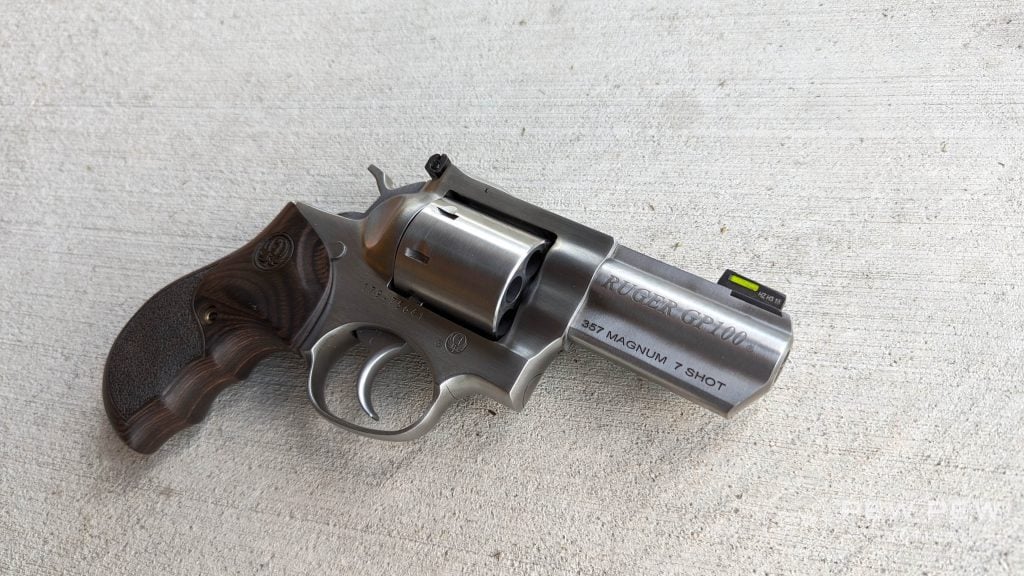
This GP100 has become my favorite revolver; keep reading to learn why…
Table of Contents
Loading…
Ruger GP100 Pros & Cons
Pros
- Great sights
- Excellent trigger
- 7 shots
- Beautiful look
- Super accurate
Cons
- Hefty
The Bottom Line
The Ruger GP100 series is a great way to dip your toes into the world of revolvers. Shooters get a reliable, accurate, and easy-handling weapon designed to last. This specific model is what I picture when you say the words modern fighting revolver. It's compact but competent and packs a punch of seven rounds of .357 Magnum.
Ruger GP100 Specs & Features
Specs
- Overall Length: 8.5″
- Barrel Length: 3″
- Weight: 36oz
- Caliber: .357 Magnum
- Capacity: 7 rounds
Features
- Fiber Optic Front Sight
- Checkered Hardwood Grips
- Satin Stainless Finish
- Triple-Locking Cylinder
GP100 Background
The GP100 series is nothing new. They hit the streets in 1985 and were an evolution of the Security Six lineup of revolvers. The Security Six was great but wasn’t built for a diet of just .357 Magnums.
Like a lot of .357 Magnums in this era, the original Security could handle them mostly fine, but it wore out considerably faster when it consumed a diet of nothing but .357 Magnums.
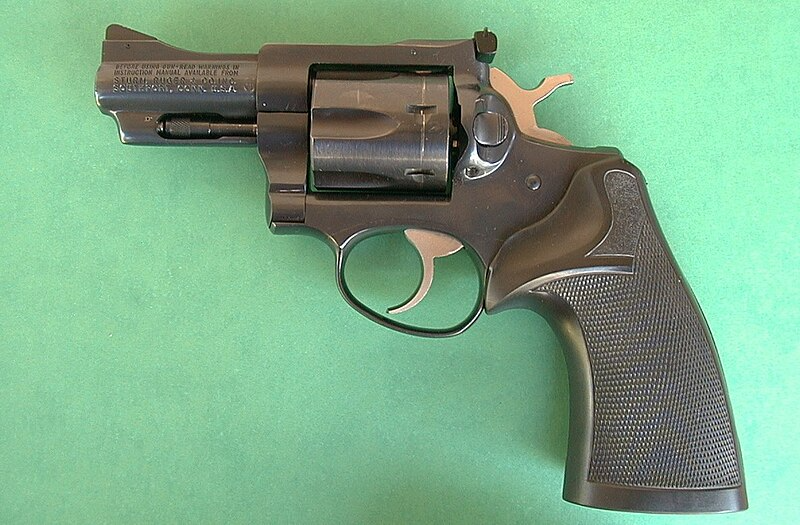
Ruger made the GP100 to be a consummate consumer of .357 magnums, and it shows. Ruger platforms use a triple lock system for total reliability and durability.
The GP100 series is literally built like a .44 Magnum. It’s just as thick and uses the same double-latching system as the Redhawk series.
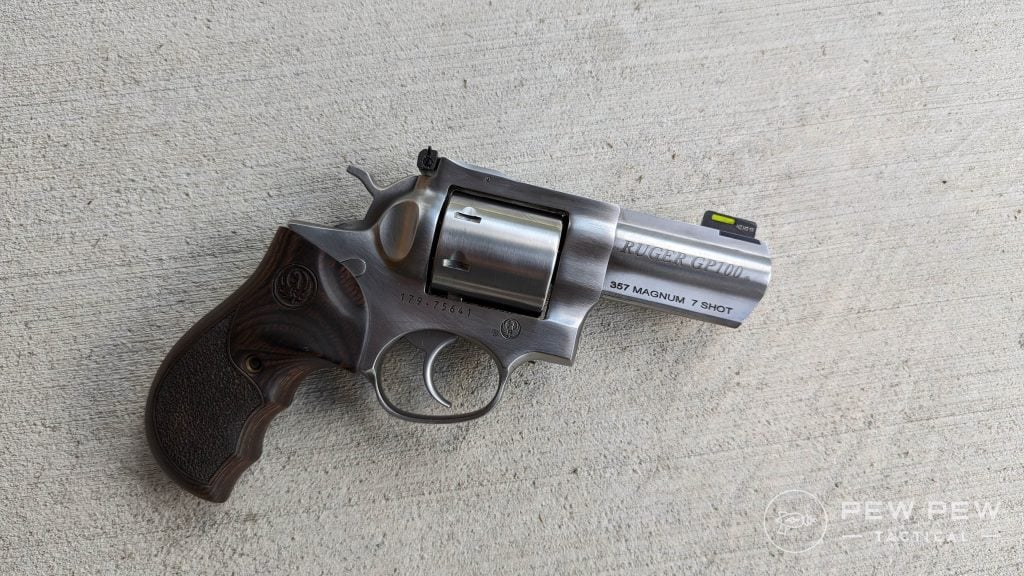
These guns break down into three separate portions and don’t require any specialized tools to break down. They lack a side plate, another durability improvement on the design.
From the ground up, Ruger wanted to build a beefy revolver, and that’s exactly what they did.
The GP100 came out too late to find its way into the holsters of many police officers, but the Greek EKAM Counter-terrorist unit and the Serbia Special Anti-Terrorism Unit adopted the GP100, likely for very specialized roles.
Who Is This For?
The Ruger GP100 series is for anyone who wants a finely tuned, well-made, durable revolver. The different calibers and sizes make finding a GP100 for various uses easy.
Who is it for?
That’s an interesting question. It’s 36 ounces of steel with a compact grip and barrel. It could be tossed into a concealed carry role. It’s no snub nose, but it’s a helluva lot easier to shoot than any snub nose.
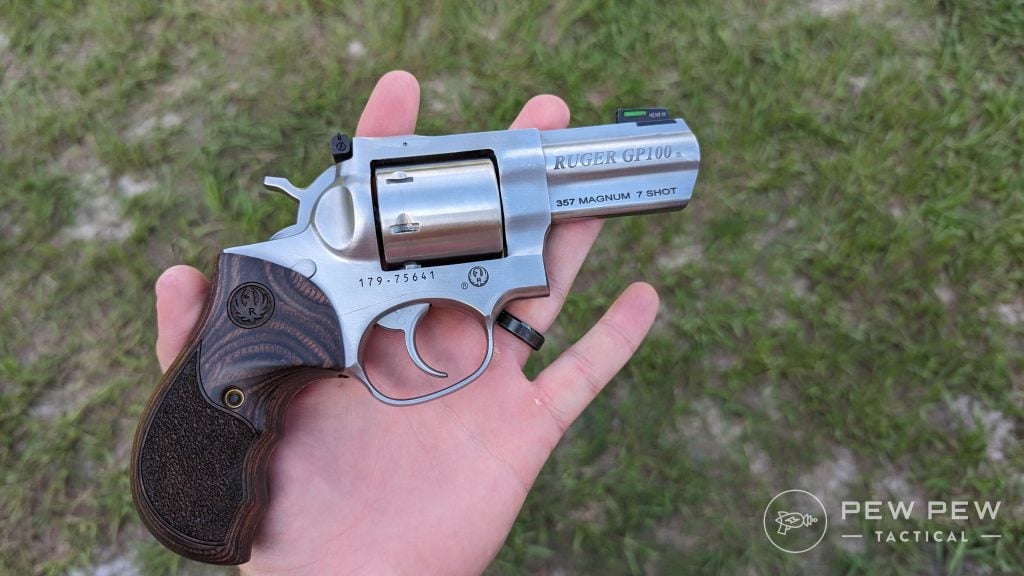
The 3-inch barrel and compact grips aren’t too tough to conceal, but it’s a hefty hand cannon. This gun could also be used for home defense, especially in states with magazine bans where the lower capacity is less of an issue.
To me, the place it shines the most is as an outdoor gun. Let’s say I’m going for a hike. My chances of dealing with two-legged vermin decreased, but my chances of encountering four-legged vermin increased.
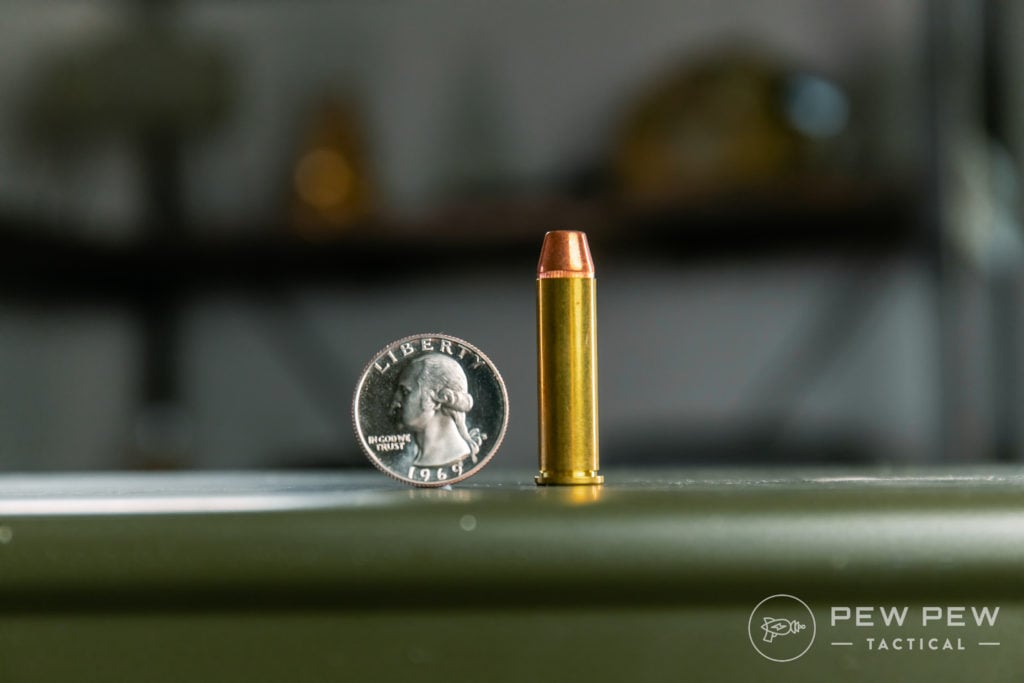
The Ruger GP100 packs a penetrating punch with .357 Magnum, and this particular model is fairly small and easy to tote. I still conceal when I hike, fish, and adventure. In that situation, I like the more powerful magnum round for dealing with hogs and the option for snake shot in the cylinder for the occasional moccasin.
(Although, to be honest, I try my hardest to avoid snakes. Snakes are bros.)
Fit & Feel
The layout of this Talo Distributor exclusive model is quite attractive to those chasing aesthetics. Yeah, yeah, function over form and all that. Why can’t you have both, though?
If looking good can be considered a feature, this revolver has it. The unfluted cylinder, the stainless finish, and the wood grips make it stand out.
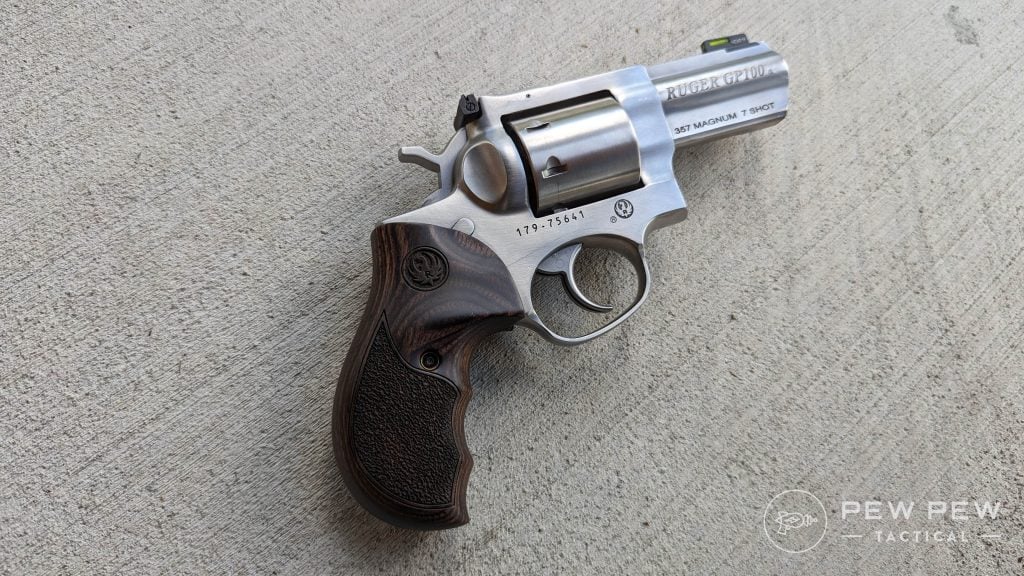
That unfluted cylinder is more or less a looks choice, but it does add a little weight to the gun, which helps with recoil. Most revolvers hold six rounds, but Ruger fits one extra in this model for a total of seven rounds.
Ruger’s wood grips are good-looking but plenty practical with a fair bit of texturing. They fit in the hand quite nicely.
At the top, we have an adjustable rear sight that’s low profile and easy to zero. Up front, we have a high visibility fiber optic front sight. It’s also easy to see and to put on target.
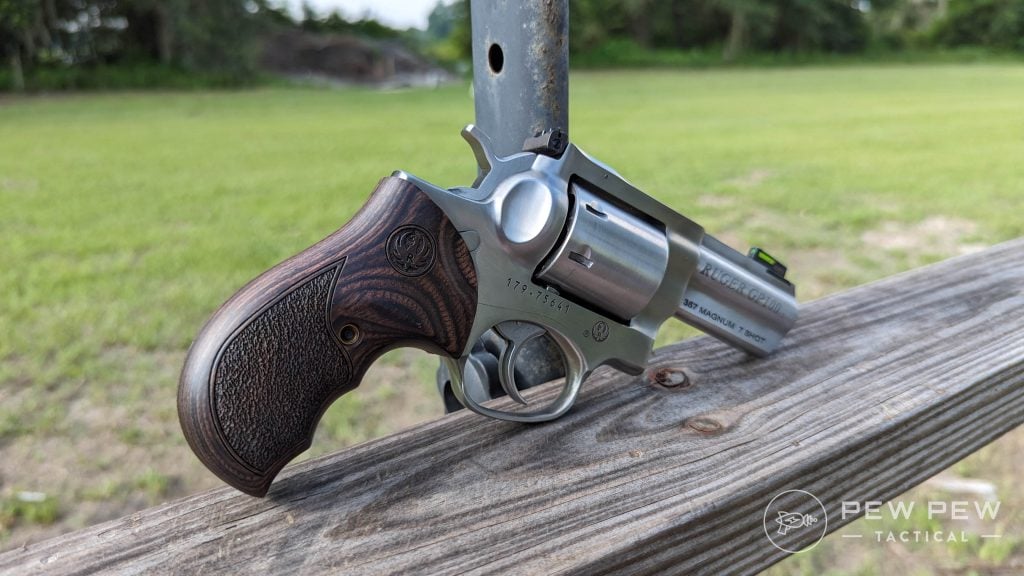
Heavy often invokes a feeling of quality, and at first pickup, the 36-ounce Ruger GP100 certainly feels like a quality firearm. Luckily, it’s more than a feeling, but more on that later. A beautiful stainless finish is certainly eye-catching and practical.
The wood grips seem old school but do fit in the hand well. A press button cylinder release is easy to engage and releases the cylinder easily. The spurred hammer is easy to cock, and the trigger is wide and easy to pull.
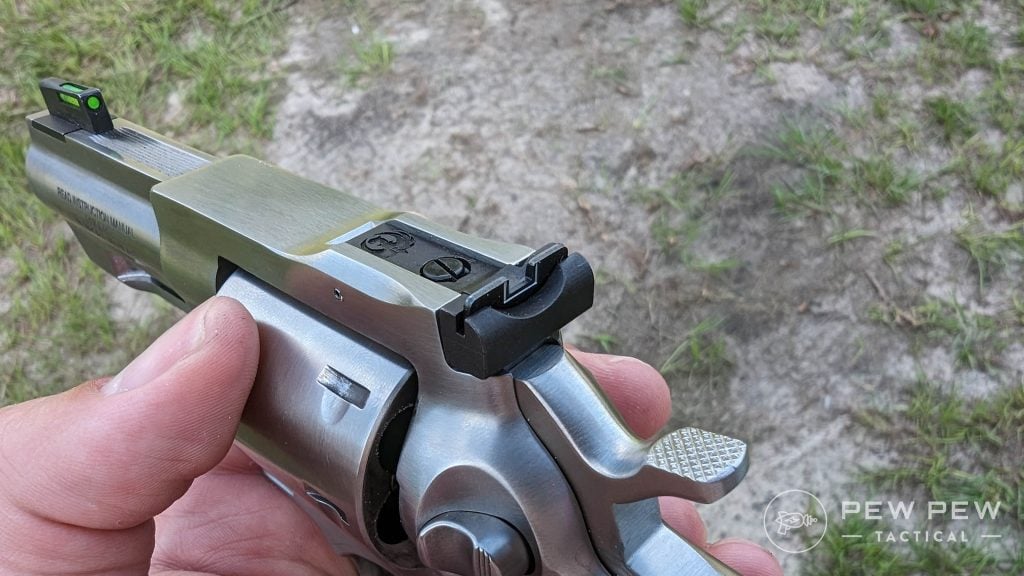
It’s a solid gun all around. The cylinder locks up tightly and revolves nicely when the hammer or trigger is pulled. Ruger crafted quite a nice revolver, and the GP100 looks and feels brilliant.
How Does the GP100 Shoot?
Like a dream! Well, that’s a bit short, so let’s elaborate. I started with a lot of .38 Special. It’s cheaper and allows me to get a lot of double-action trigger reps in.
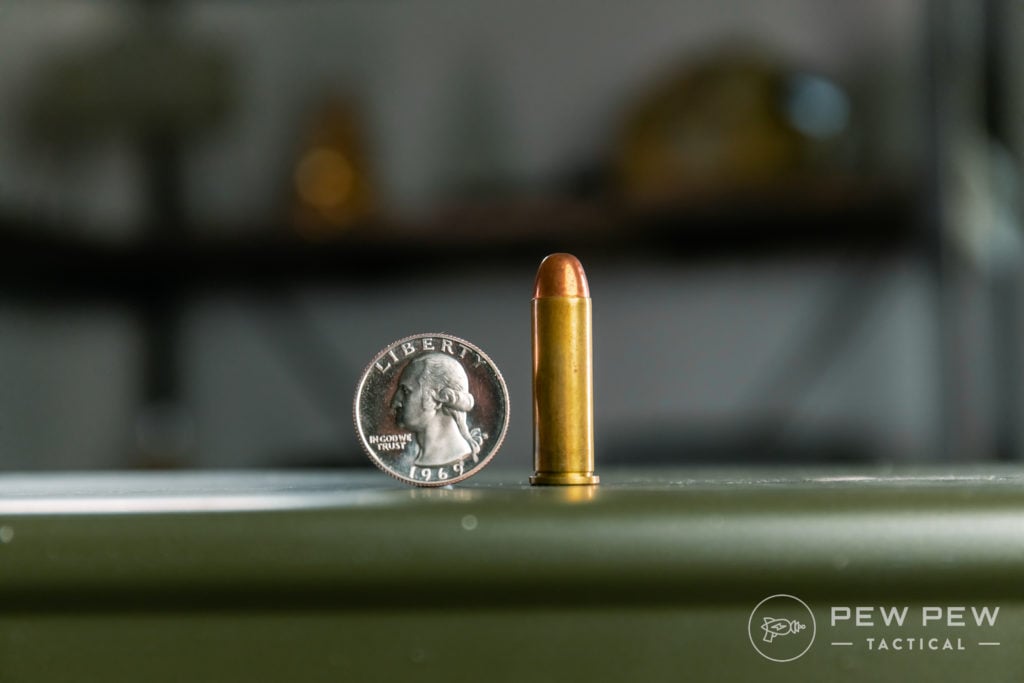
A 36-ounce revolver makes the recoil from a .38 Special feel like nothing. It was grin-inducing the first time I fired it. Recoil was nearly nothing, and the .38 Special loads made the gun very easy to shoot.
With .357 Magnum, there is a noticeable increase in recoil and noise, but the gun never becomes tough to handle. That weight eats recoil well, and even the hotter .357 Magnums can’t make it tough to shoot.
Firing a double tap of .357 Magnum is well within the realm of possibility.
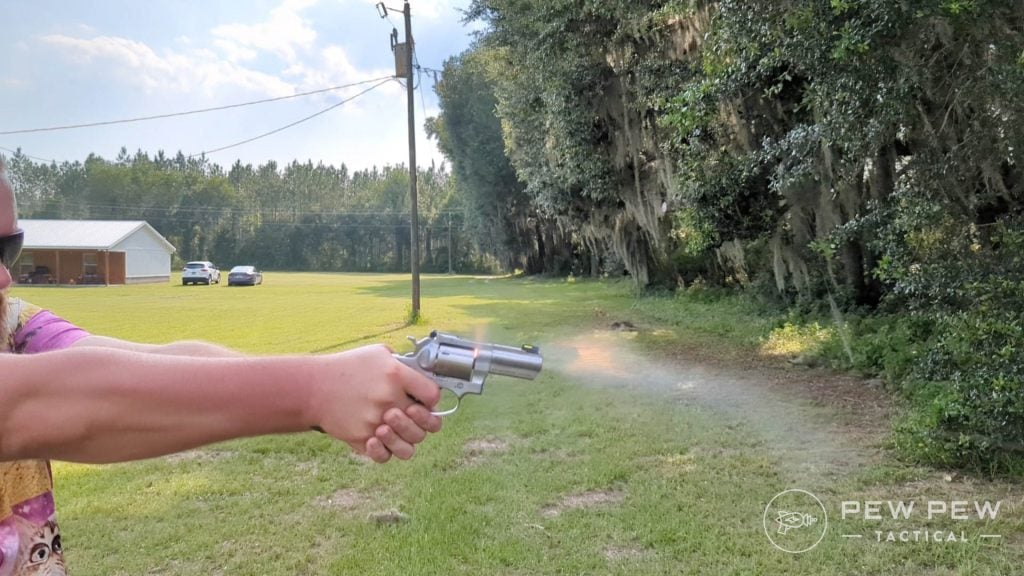
I would feel comfortable handing this gun to a somewhat new shooter looking to fire their first magnum-powered pistol. One of the biggest benefits of the shorter 3-inch barrel is the excellent balance the gun provides.
This shorty GP100 doesn’t ever feel front-heavy or off-balance.
Accuracy of the GP100
In the accuracy department, the gun deserves a better shooter. I’m fairly inexperienced with revolvers, but even I could keep my shots in the black of a B8 at 15 yards, shooting double action only. In fact, under a timer, I fired a modified 10-10-10 drill.
Obviously, the gun only holds seven rounds, so I fired seven rounds within 10 seconds at 10 years in double action only and landed all seven in the black. The little recoil does make the gun easy to shoot quickly.
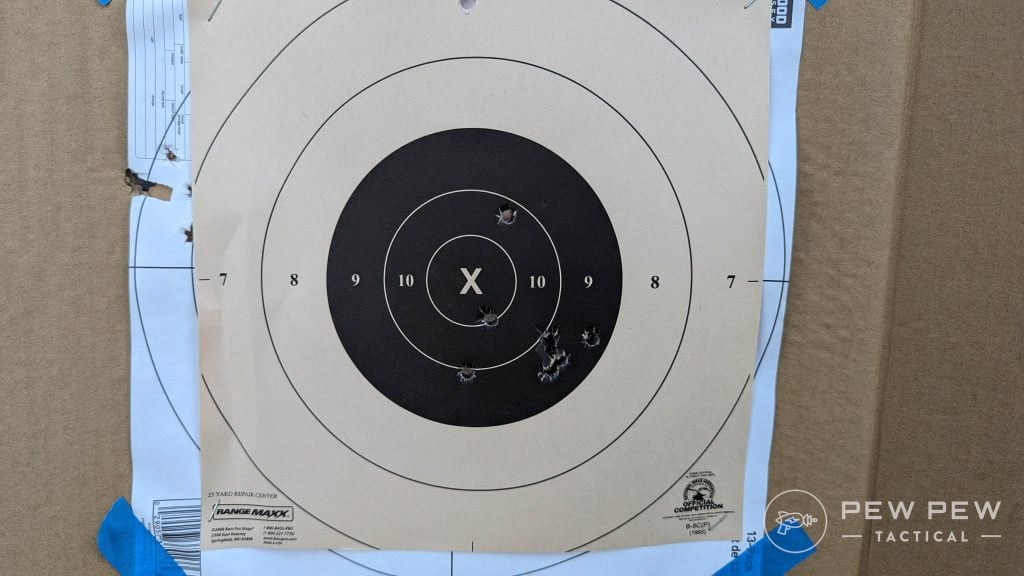
Like all double-action triggers, it is long and heavy, at least long and heavy compared to striker-fired guns. That long and heavy trigger is lighter and smoother than most revolver triggers and was impressive. I put in a lot of dry fire reps, and the trigger never tired my wee little finger.
Accurate shooting pretty much all comes down to pulling the trigger without disturbing the sights, and I could mostly do that with the GP100.
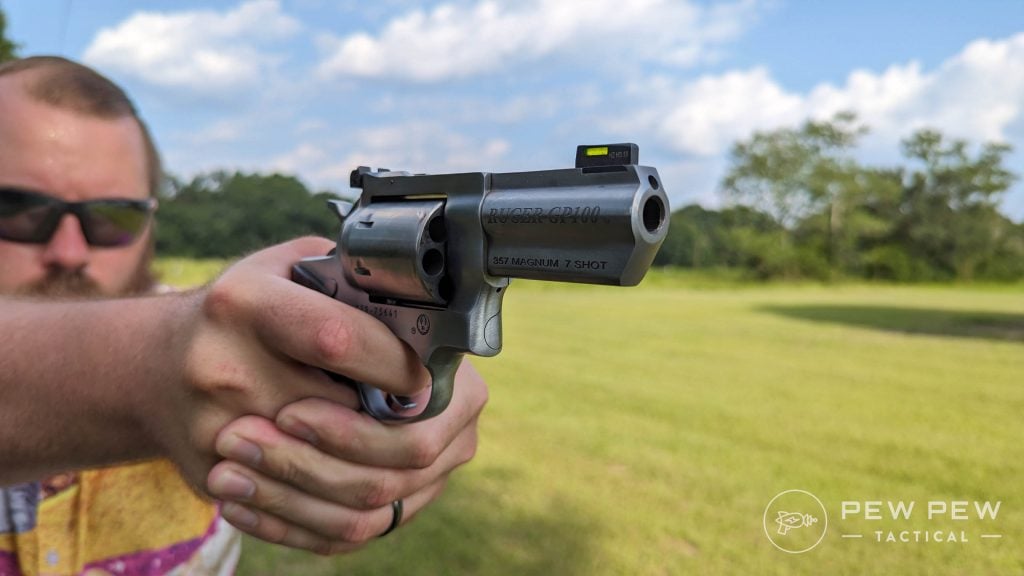
In my experience, the .357 Magnum rounds were considerably more accurate than .38 Special. They tended to group a bit tighter when fired side by side.
I fired 300 .38 Special and 150 .357 Magnum rounds. My ammo was Remington .357 Magnum and American Eagle .38 Special. There were zero issues in terms of reliability through all 450 rounds.
My one slight issue comes down to ejecting the empty shells. Occasionally, one will get stuck just a bit on the edge of the gun’s grip, requiring a slight cylinder rotation to free that last round.
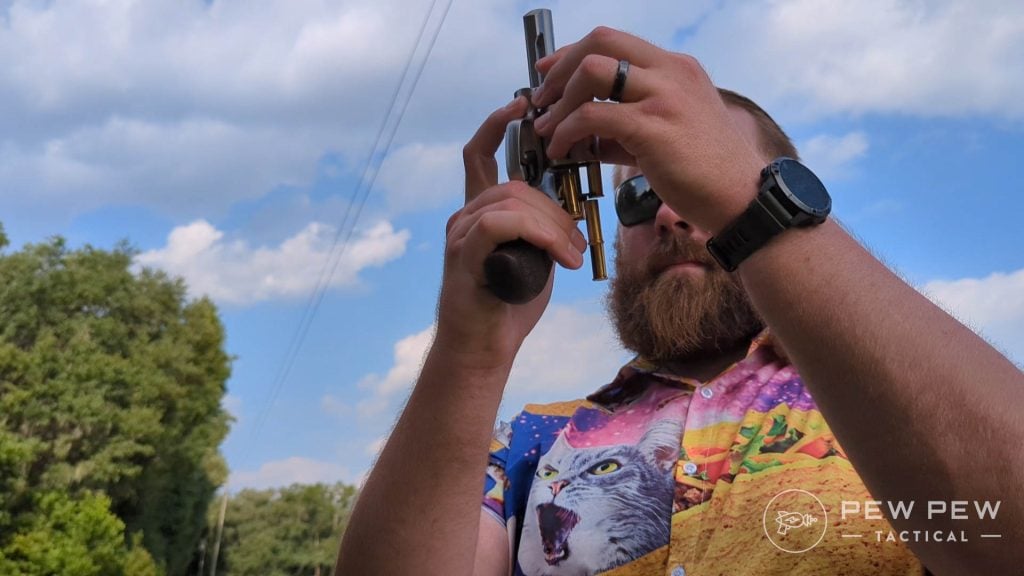
What Sets the GP100 Apart
The GP100 series, in general, are made to be tanks. They can take a helluva beating and just keep functioning.
Ruger’s series can handle piles of ammo without issue, and if you ever run out of ammo, the hefty, tank-like design makes the GP100 well-suited for melee use.
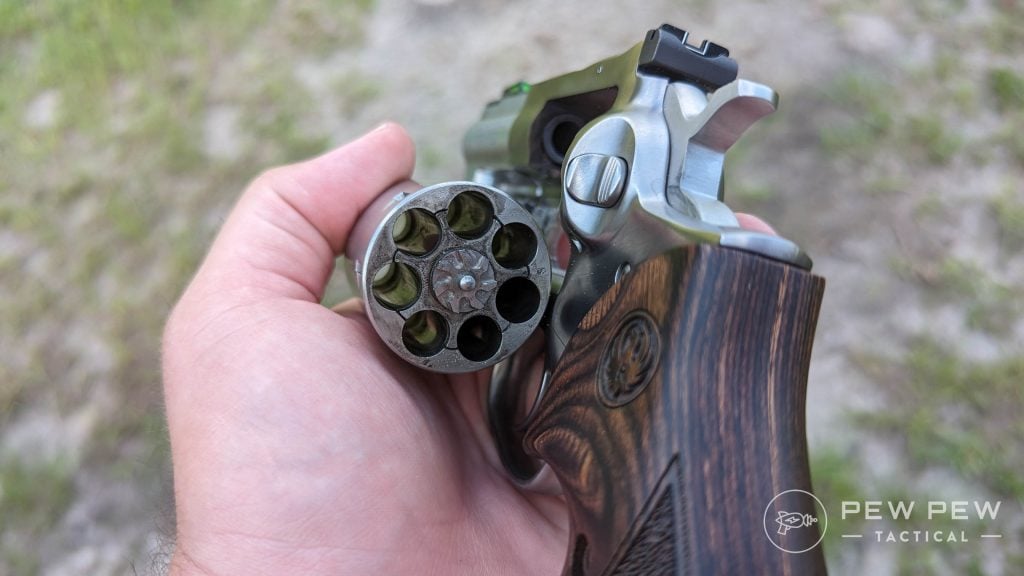
This specific model is an interesting combination of features. The shorter barrel and smaller grips paired with the seven-round cylinder make it a standout.
Plus, the presence of actual sights is quite nice to see, and for a revolver newb like me, it makes the gun easy to shoot.
Ruger GP100 By the Numbers
Accuracy
4/5










The GP100 shoots better than I can. The adjustable sights are nice, the trigger is excellent, and you know what? It shoots straight. A longer sight radius would give it an extra edge to reach five stars.
Reliability
5/5










This thing is a tank, and it can seemingly fire anything and do it over and over.
Customization
3/5








The GP100 series tends to be fairly popular, so there are options for it. New grips, the ability to add a red dot, and a few more little things, but it's still a revolver, so customization is limited.
Ergonomics
4/5









Overall, there are no major complaints. The cylinder release is easy to press, the hammer easy to reach, and the grips are fantastic. I have one slight issue with always getting that seventh round post the grips, but that's it.
Value
3/5








The Ruger GP series is probably the best revolver you can get for under $1,000. While it's certainly not budget-priced, the GP100 seems cheaper than guns like the 686+ and Colt Python.
Overall
3.5/5









Prices accurate at time of writing
Prices accurate at time of writing
-
25% off all OAKLEY products - OAKLEY25
Copied! Visit Merchant
Ruger GP100 Accessories & Upgrades
Final Verdict
The GP100 is a fantastic revolver. It’s extremely well made, a ton of fun to shoot, and accurate, too.
For a beginner like me, it was a great way to ease into revolvers and made me excited to continue my wheel gun journey.
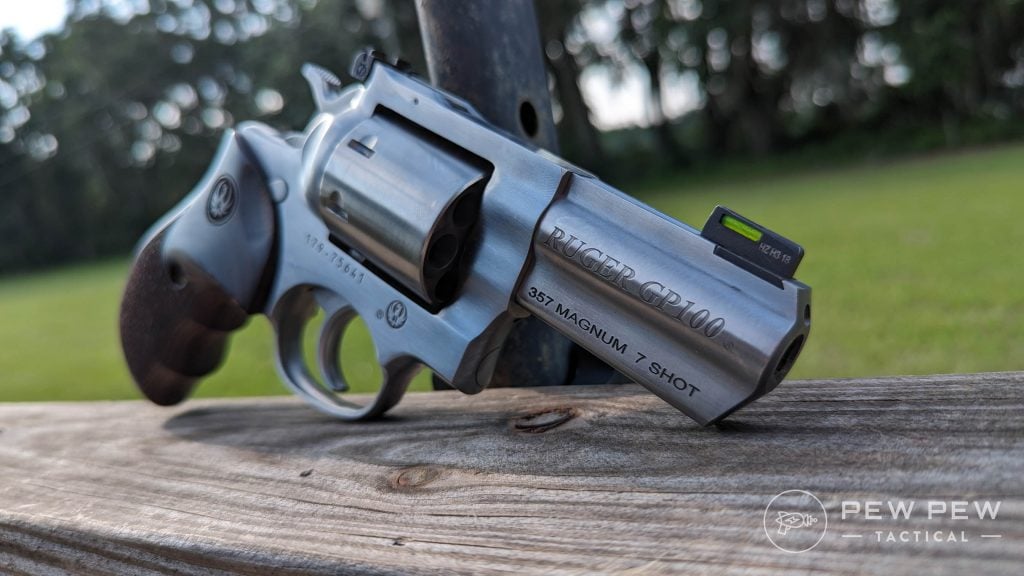
What do you think of the GP100? Let us know in the comments below. For more beginner-friendly revolvers, head to our round-up of the Best Revolvers for Beginners.

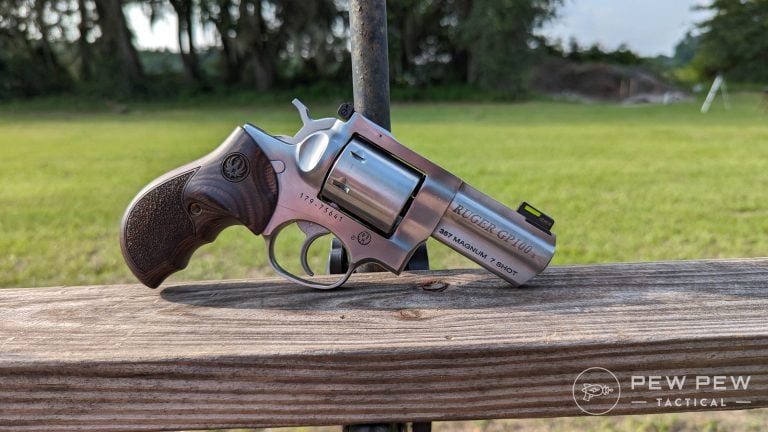
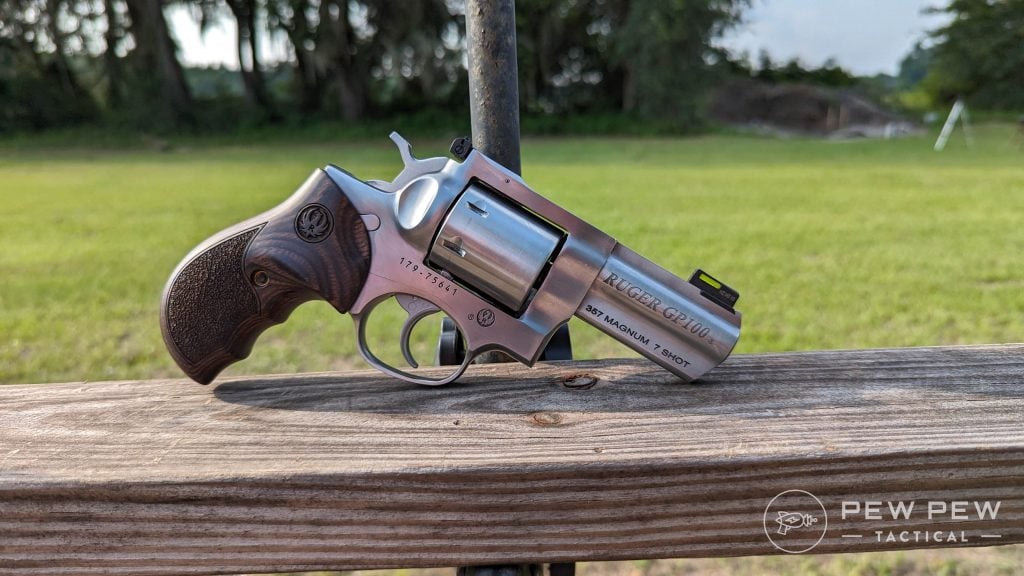


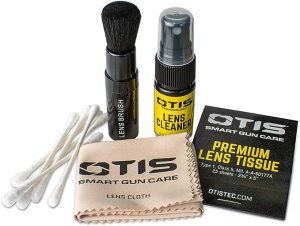
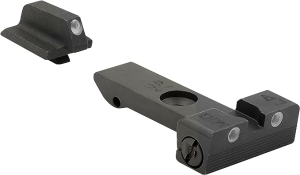
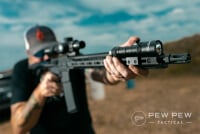






12 Leave a Reply
I bought a Security Six about 50 years ago when I lived in Alaska. I used it on a fishing trip to scare away a momma bear who was protecting her cub- didn't shoot her, just put a couple rounds near her. Great gun, very solid.
You can put a nice scope on a four or six inch gp100 with a mount and rings from Jack Weigand. No drilling; you replace the front and back sights with the scope base. Save the original parts and you can go back to open sights anytime. A fixed 2X scope is all you need out to 75 yards or so, which is about your .357 mag limit anyway. Lighter, tougher, than a variable with a sharper image. Very bad-ass looking and performing.
Older review, but some comments nevertheless. My first firearm in the early 1970's was a Ruger Security Six shortly after they were introduced. I was under 21, but over 18, so my father bought it for me. It was my carry weapon for a couple of years. Like others in that era I had to load it with FMJ .38 Special. Got in a bit of trouble one day carrying when I had 158 grain SP . Sold it (and wished I hadn't later) when I went on active duty with the US Army (owning a personal firearm wasn't prohibited, but all the regulations about storage, transport and shipping between duty stations was a PITA). I've got a full size RIA M1911A1 and Beretta M9 now, along with a Sig P238, but I yearn for the .357 magnum. Not certain why someone would state it shouldn't be a first firearm or handgun. I do recommend the 4.2" barrel versus 3" as it gives you a longer sight radius with inherently smaller circle of error in sight picture and probability of greater accuracy with it. That's why many folks with the short barrel pocket pistols have marksmanship trouble, particularly if they've never used a pistol or revolver before. Regarding starting with a small caliber like a .22:LR. the M1903 Springfield, M1 Garand and M14 were first firearms for millions of draftees, as was the M1911 and M1911A1 and they didn't have to start out with pea shooters or straws with spit wads. They did just fine. Regarding using a .357 for personal protection, it's essential to know and consider what's behind your intended target, and using 158 grain or heavier hollow point or soft point ammunition that will expand. FMJ runs a much higher risk of pass through, hitting whatever is behind the intended target.
I started shooting about a year ago (I'm 83) and I found that the semi-autos are too fussy about how you hold them when firing - hold them wrong and they jam. With the stress In a real situation this is too likely to happen and clearing the jan under stress chancy. You can hold the GP-100 any old way and it still goes bang when you pull the trigger and doesn't jam. Very good for home defense but a little big for concealed carry, although I have carried it in a briefcase,
Man I love the fact that at 83 yo you carried this cannon in a briefcase. Awesome and rock on!
My First handgun, loved it then over 30 years ago and still love it.
Great review. The GP-100 was the first handgun I ever purchased...on the day I turned 21 actually. And that was 1991! I believe I paid $325
Today, she looks almost like the day I bought her, and has never malfunctioned. So I would highly recommend the caliber and manufacturer and model. I do like most Ruger products.
Thanks Charles and glad your GP is still like the day you bought her!
Boompa....I too fell in love with the TALO edition. The unfluted cylinder and wood grip are beautiful! I ordered mine yesterday and can not wait to take it to the range.
As a long time fan of semi auto's I never thought I'd buy a wheel gun. But recently I was longing for something different, something that stood out amongst the plastic fantastics that crowd my gun safe. Once I decided to add a revolver to my collection the decision to purchase a Ruger was easy. I have several of their semi auto's and they are accurate and well built. An added bonus is the fact that the GP 100 is built in New Hampshire, my home state :)
I'm not sure how many of these TALO editions they made but I'm sure glad they are still available. It has to be the most beautiful handgun I've ever seen. An heirloom piece for sure.
It was more than I wanted to spend but like you said some decisions in life don't need to be justified :)
Thanks for the insight Dave! Man, I need to get my hands on one of these TALO edition ones...I keep hearing about them!
Wow, thanks for the deep insight!
Name and email fields have accurate entries.